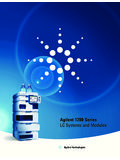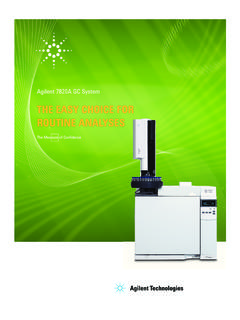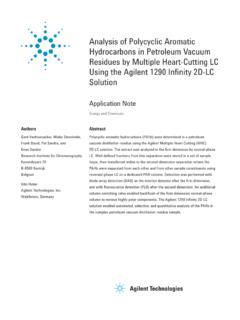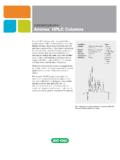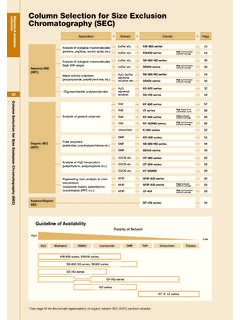Transcription of An Introduction to Elevated Temperature in HPLC
1 1 An Introduction to Elevated Te m p e ra t u r e in hplc Theory and principles for Elevated Temperature and Temperature programmed liquid chromatography The SandraSelerity Polaratherm is designed to enhance the analysis of chemical mixtures through hplc at Elevated and sub-ambient temperatures . Although often neglected, Temperature plays an important role in hplc since the majority of the chromatographic properties are a function of Temperature . Nevertheless, to this date the possibilities of Temperature to improve LC separations have not been fully investigated and the majority of liquid phase separations are performed in the Temperature region between 20 to 40 C or without thermostatting.
2 The use of Elevated Temperature has proven effective for improving the overall chromatographic performance on conventional equipment. The main advantages of using Temperature in LC are: 1. Speed Increase speed by increasing the Temperature and flow rate. 2. Efficiency and resolution Increase efficiency by using longer columns/smaller particles at Elevated Temperature . 3. Selectivity Change selectivity with Temperature . 4. Lower consumption of organic solvents - Green chromatography Higher Temperature requires less solvent.
3 5. Improved detectability Improve peak shape. Use only water. 6. Temperature programming Replace solvent gradients with a Temperature program. 2 1. Speed The current trend is to use shorter columns with smaller particle sizes, typically less than 2 m, for increasing the speed. This has the disadvantage that the pressure drop over such columns is drastically increased. Furthermore, to fully exploit the potential of such sub-two-micron columns high linear velocities have to be used. The combination of the intrinsic high backpressure and the required high flow rate causes analysts to reach the upper pressure limits of conventional LC systems.
4 The recent Introduction of ultra-performance or ultra high pressure LC (UPLC) equipment has partially overcome this problem. In nearly all reversed phase separations, an increase in Temperature will also cause a decrease in retention. Additionally, decreased solvent viscosity at Elevated Temperature (1-2% per C) leads to lower back pressure. This allows the use of higher flow rates using standard equipment. Since high Temperature leads to a flatter van Deemter curve, it enables the use of higher flow rates without hampering efficiency (Figure 1).
5 An increased flow rate is even favorable to fully benefit from the increased Temperature . The application of high Temperature enables the use of columns packed with sub-two-micron particles at high flow rates. In this way it is possible to exploit the advantages of these columns using conventional LC equipment. Linear Velocity (cm/s)Plate Height ( m)12 14 16 18 20 22 24 26 0 1 2 25 C 80 C 120 C 150 C Figure 1.
6 Plate height versus linear velocity. 2. Efficiency and resolution The efficiency that can be realized on one particular analytical setup is relatively independent of analysis Temperature provided that adequate preheating of the mobile phase prevents radial Temperature gradients. At Elevated Temperature however, the solute transfer from the mobile phase to the stationary phase is more efficient. This results in high efficiency, even at Elevated flow rates. The low back pressure allows the use of smaller particle sizes and/or longer columns to increase efficiency and resolution.
7 3 This also opens perspectives for increased efficiency and resolution in preparative LC. Instead of multiple collection sessions to completely resolve all of the compounds, a single method with increased resolution can provide a more elegant and productive alternative. In practice, conventional LC columns can be coupled in series and operated at Elevated Temperature to decrease the backpressure ( four 25 cm columns result in a total column length of 100 cm). Since the column plate number is determined by column length, efficiency will increase proportionally with column length.
8 3. Selectivity The stationary phase, mobile phase pH, organic modifier, and several other parameters determine selectivity in LC. Temperature is a parameter that also plays an important role in this aspect. This is especially true for polar and ionizable compounds since ionization equilibria are Temperature dependent. Even more, because it is an instrumental setting, Temperature is one of the easiest and most straightforward parameters to change and control in order to tune chromatographic selectivity.
9 This has been reported frequently in the literature, yet its potential role in method development is still often underestimated. 4. Lower consumption of organic solvents - Green chromatography By increasing the Temperature , the amount of organic solvent in the mobile phase can be reduced to maintain retention. Roughly, a Temperature increase of 4 or 5 C has a similar effect on retention as a 1% increase in methanol or acetonitrile, respectively. Superheated water at 200 C has a similar eluting power as methanol at ambient Temperature .
10 Additionally, since the back pressure is reduced at Elevated Temperature , ethanol becomes a practical alternative for toxic solvents such as methanol and acetonitrile. Mobile phases composed of water, ethanol, and additives like ammonia and acetic acid can be considered non-toxic and can be used for green chromatography. 5. Improved detectability The reduced amount of organic solvent in the mobile phase also results in additional advantages. The mobile phase UV transparency in the low UV range is improved.
